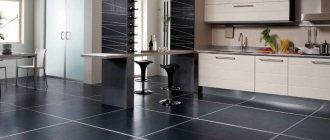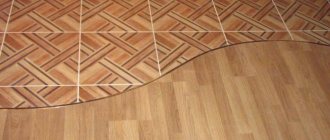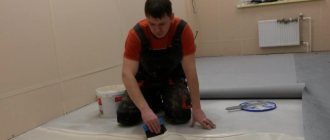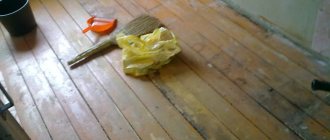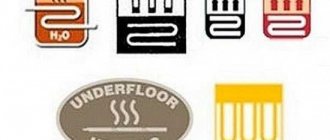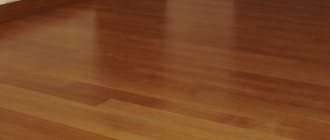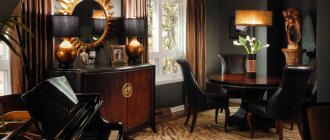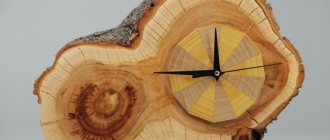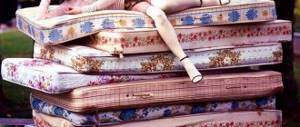Why do you need a substrate under linoleum?
In general, the substrate is used to solve one problem - thermal insulation. But due to the similarity of the principles of heat and sound propagation (Debye model), it serves as a good sound insulator.
There is another problem that can be solved with its help: leveling out minor unevenness in the base. To be fair, it is worth noting that not all substrates are designed to cope with this task. Meanwhile, it is for soft floor coverings, and for linoleum in particular, that this aspect of the issue is dominant.
Base for linoleum: underlay for concrete floor
A concrete base is ideal for laying linoleum, provided it is first leveled. To do this, use special mixtures, make screeds or use the floating floor method. On concrete floors, underlayment is most often used. The installation procedure provides for a certain sequence of work:
A concrete floor underlay is necessary for leveling and insulation
- base preparation includes cleaning and leveling the surface. After completing the concrete screed, the floor must dry completely. This may take up to 30 days;
- elimination of defects. After pouring the floor, small defects sometimes form. The tubercles can be knocked down or cut off, and the holes must be filled with a self-leveling mixture;
- waterproofing. After final drying, the surface is covered with a waterproofing layer. A simple polyethylene film covering the floor as a single sheet is suitable for this. It is imperative to provide an overlap of 3-4 cm on the walls;
- installation of the leveling layer involves laying plywood or other wood-based materials. Sheets of plywood are laid with a margin of 5 mm from the wall. Subsequently, the gap and seams between the plates are filled with sealant. Fix the material with small dowel nails (5 mm) at a distance of 60 mm from each other. The fastening material should not protrude, and dents should be covered with putty;
The rolled substrate is rolled out and laid end-to-end without overlap.
- roll backing flooring. The material is rolled out and laid end to end, without overlaps. The seams are taped with gray reinforced tape.
What types of substrates are there?
They can only be divided according to the origin of the material into:
- Natural"
- Polymer;
- Combined.
Each of these types of substrates has its own general pros and cons. Although there are also weak points that are inherent in most materials.
Let us immediately note that in terms of release form they come in both rolls and sheets. Thickness varies from 2 to 12 mm.
The following fact is interesting. All materials used to make substrates have the same low thermal conductivity coefficient. The difference of 10-15% between individual groups, against the general background of finishing materials, is not significant. Therefore, this indicator is not used for comparison. Products based on flax and jute stand apart in this group. But they stand out in a special group.
Natural substrates
Natural substrates made from:
- Flax;
- Juta;
- Felt;
- Traffic jams.
Flax and jute, although different plants, the material obtained from their fibers has the same performance characteristics. They are produced using similar technology. They form a special group because, unlike all other materials, the air chambers in their thickness are open. Their use is justified if you are laying new linoleum on top of the old one.
Felt backing is made from wool. It is rarely combined with linoleum - it is too soft. Its use is preferable in children's playrooms and provided that large and heavy objects will not be placed in the room. Otherwise, the furniture will push through the flooring by several millimeters in 1-2 months.
See also: Tile adhesive
Cork backing is made from pre-crushed cork oak bark. This is a special material that deserves to be discussed in more detail. In general, cork can be thought of as an intermediate product between wood and wax. It contains both lignin, the basis of wood, and cerin, a component of beeswax. In addition to these ingredients, it contains other components, but it is they that give cork the qualities for which it is so valued: lignin - hardness, and cerin - water resistance. Cork, as a complex conglomerate of components of natural origin, in addition to everything, has excellent elasticity.
The cork substrate has the following characteristics:
- Elasticity;
- Hypoallergenic;
- Waterproof.
But waterproofness does not mean that moisture does not have a destructive effect on the cork in its pure form. A special feature of cork as a natural material is the presence of air in closed pores. In other words, flax, jute and felt can be compared to mineral wool heat insulators, but cork can be compared to polystyrene foam.
In any case, all substrates are made from natural ingredients and undergo a stage of treatment with fire retardants and antibacterial compounds.
Purpose of the substrate for linoleum and its varieties
The substrate is an elastic insulating material that performs two quite important functions:
- Leveling the base. Laying linoleum should be done on a perfectly flat surface, but not everyone has the time or opportunity to make a professional screed in the room. In this case, a substrate is simply necessary, since only with the help of this material can existing mounds, depressions and other small defects be compensated.
- Insulation of the base. The unique thermal insulation properties of the substrate will be very useful if there is a basement or unheated room under the base of the floor. If there is an underlying layer on linoleum, insulation can be neglected, but if one is not provided, then the substrate is a mandatory element. In some cases, in order to improve thermal insulation, both a substrate and a linoleum coating with a base are used.
Let's look at the most common materials that are laid under linoleum.
Jute backing is an environmentally friendly material made from 100% jute fiber. This insulation is obtained by rolling needle-punched jute on rollers under high temperature. Subsequent fire-retardant treatment gives the material increased resistance to burning, rotting and mold.
Linen backing – this insulating layer consists of natural linen. Its production technology involves double punching with a needle and subsequent treatment with fire retardants and anti-fungal compounds.
Combined backing - consists of a mixture of jute, flax and wool. The insulating layer, made of mixed material, has a fairly high density (500-700 g/m² with a thickness of 2-3 mm).
Cork backing is a material ideal for laying laminate or ceramic tiles. If it is used under linoleum, the floor covering will be too soft. Of course, this can add comfort when walking, but such a floor is unacceptable for heavy pieces of furniture. If there is no question of choice, you should choose the option with the highest degree of rigidity.
Important note! A porous polymer substrate for linoleum based on penofisol and isolon, recommended by some builders, will absolutely not bring you anything good. This material does not have heat-insulating properties, quickly loses its original shape, does not give heavy objects the necessary stability, and even causes noticeable discomfort when walking on the floor.
Polymer substrates
This group consists of only two representatives:
- Polyethylene foam;
- Expanded polystyrene.
There is a very important note here. In their usual form, these are good thermal insulators, but with very poor elasticity. They crumple, and with prolonged exposure, do not restore their shape. Therefore, special technologies are used that qualitatively change these indicators.
Moreover, the resulting products even have a different name:
- Cross-linked polyethylene foam;
- Extruded polystyrene foam.
But in the first case, “cross-linking” occurs by processing the finished product, by irradiation with a stream of high-energy particles, which leads to the formation of additional bonds between the layers of oligomers.
But expanded polystyrene is already produced using a different technology, resulting in a product with fundamentally different physical characteristics.
As mentioned above, their basic parameters are identical. But there are significant differences:
- Extruded polystyrene foam is less attractive to rodents;
- The emission of harmful substances (styrene) is higher. Although it does not exceed the MPC;
- Expanded polystyrene is absolutely unstable to the action of many household solvents.
See also: Semi-commercial linoleum
If it were not for the last point, then extruded polystyrene foam would have no competitors, but physically cross-linked polyethylene foam occupies a leading position in this group.
There are foam polymer substrates with a reflective layer (foil materials). This “upgrade” of the material increases the thermal insulation coefficient by 5-7%.
What you need to know about linoleum?
Laying linoleum with glue.
Lags. This type of lining is actively used for apartments located on the ground floor or for one-story houses. In this case, the floor must be additionally insulated. Without this, the house will be quite cold. As a result, residents will experience constant discomfort. What does this method look like?
- First, logs are installed on the floor surface, then the space between them is filled with special insulation, for example, mineral wool.
- A layer of chipboard is laid on top of the logs, and fiberboard is attached to it. Thanks to this design, you can make a perfectly flat floor, on which linoleum is laid on top.
Related article: Gypsum plaster walls from A to Z for beginners
Floating screed. For houses with several floors, this type of lining is used, such as a floating screed. Due to the fact that it does not have a rigid fastening, this option is suitable for those who want to additionally soundproof their apartment. The screed also allows you to level the floor.
Flooring made of fiberboard. In order to level floors, fiberboard is widely used in construction. This type of coating has a second name - MDF. It is a sheet of compressed wood fibers.
- Fiberboard has a number of advantages: it is durable, inexpensive, and made from environmentally friendly types of wood.
- With proper use it will last a long time. But do not forget that before laying linoleum on fiberboard, it should be covered with drying oil, several times. This will prevent swelling upon contact with moisture.
- Its one main disadvantage is its pungent and very unpleasant smell. Therefore, after treatment, you will have to thoroughly ventilate the room for several days. And don't forget about your neighbors. It is better to warn them in advance to avoid conflicts in the future. And such additional advantages as sound insulation and heat retention will undoubtedly be appreciated by consumers.
Laying scheme for linoleum.
Cork backing. An equally common coating option these days. In order to give the floor additional softness, use a cork backing. It consists of thin layers made of crumbs, which are glued together with a special wood glue.
But do not forget that heavy interior items, such as a sofa, chest of drawers or a large wardrobe, can leave dents on the linoleum. To avoid these troubles, you should purchase a cork backing with the maximum level of rigidity.
This option is perfect for decorating a children's room, since the substrate contains no harmful chemicals. The only negative is the high price.
Article on the topic: CMC adhesive for wallpaper: technical characteristics
Linen backing. This is a version of a roll backing. It is highly environmentally friendly due to its composition. Almost 100% of this type of substrate consists of flax.
The big advantage of this material is its ability to “breathe”. Your home will maintain optimal humidity levels. But do not forget that linen is not an elastic fabric. And the cost of such coverage is also high. Therefore, before you put this option under linoleum, evaluate your capabilities.
Jute fabric. This material is widely used as a substrate. It looks like burlap. Thanks to the natural composition of materials and impregnation agents, jute fabric can be classified as an environmentally friendly product.
The advantages of this lining include the ability to absorb moisture without deforming, low cost, and long service life. And the main disadvantage is elasticity. The material is unlikely to significantly correct uneven concrete floors.
Combined substrates
This group consists of materials whose structure includes several ingredients. Moreover, they can be of the same order, such as substrates made from a mixture:
- Flax and jute;
- Linen, jute and felt.
But there are also substrates based on cork chips, to which a bitumen or rubber binder is added.
If a mixture of homologous components only leads to a change in price, without a clear improvement in consumer qualities, then mixing materials with different structures results in a very interesting product. In particular, cork substrates with binders such as rubber or tar dramatically improve their hydrophobic properties. Of course, you can’t lay them on a damp screed, but you can do without waterproofing. The resistance to biological destructive factors, such as fungus and rodents, also becomes higher.
Types of substrates
There are a great variety of substrate options offered by the modern building materials market.
First, let's list the most popular ones:
- cork,
- linen,
- jute,
- mixed or combined,
- made of porous or foamed polymer,
- wood fiber (coniferous).
Natural flax and jute fibers are hygroscopic (absorb moisture)
Now let's look at these types of substrates in more detail:
- Cork backing consists of cork granules (crumbs) obtained from the bark of the cork oak tree, pressed into a canvas under pressure and temperature. This is a completely natural material that also has bactericidal properties. This substrate is an excellent heat insulator and noise absorber. Another thing is that it will sag under the influence of a mass of heavy objects. If you decide to use a cork backing, choose the one that has the greatest rigidity.
- Linen backing is also a completely natural material (consisting of 100% linen), which is obtained using double needle punching technology. Next, the resulting product is treated with compounds that prevent combustion, formation and development of fungus. This substrate also has heat-insulating and noise-absorbing properties. Its rigidity is low, so it will definitely sag under heavy objects.
- Jute backing. This type of substrate also consists of 100% natural substance – jute fibers. It is also obtained by punching with a needle, and then additionally rolled with rollers under the influence of high temperatures. Being treated with special compounds, the substrate acquires fire-retardant qualities and properties that allow it to resist rotting and mold. This substrate also retains heat and absorbs noise, but, like the previous one, it collapses under the weight of objects placed on top.
- Mixed backing is obtained from mixing three types of fibers - linen, jute and wool. Its manufacturing technology is similar to the previous ones. This combined substrate has a high density (from 500 to 700 g/m2 with a thickness of 2-3 mm), which increases its heat-insulating and noise-absorbing properties. Unfortunately, it will also sag a little under massive objects, although less than linen or jute.
- Foamed or porous polymer - such a substrate has excellent heat and sound insulation properties. It is also very inexpensive for the buyer. This is where its positive qualities for laying linoleum end. Its softness does not allow it to be used under linoleum, since it will sag and crumble very much even under the weight of a person.
- Wood fiber (coniferous) substrate is a fairly new material on the market. It is obtained from coniferous wood. This substrate has excellent heat and sound insulation properties. It also collapses under the weight. In addition, we often hear reviews that after laying it on the floor it emits an unpleasant odor. They say that this smell disappears soon, so it's up to you to choose.
Coniferous resin protects wood from rotting, but has a strong specific odor
Features of use on different floors
IMPORTANT: The underlay should be used regardless of whether the linoleum has a base or not. It not only increases heat and sound insulation and levels out minor unevenness in the base. But it also acts as protection against contact with the base.
In concrete foundations, after the screed has fully matured, moisture remains. Its emission varies depending on air humidity, temperature and even atmospheric pressure. Linoleum, even on a special basis, will take on this destructive effect. To minimize it, the substrate protrudes. But when using substrates made of natural material, it is necessary to organize waterproofing using a thick polyethylene film.
Temperature fluctuations lead to changes in the geometric dimensions of the room. And with concrete, the coefficient of thermal expansion is much more noticeable than with linoleum. In this case, the substrate takes the main blow.
The passage of thermal and sound waves through dense materials is described in detail in the Debye model. To reduce heat loss and increase sound insulation, it is necessary to create a “layer cake” on the floor. In this case, the substrate helps out.
See also: How to lay laminate flooring
Please note that when organizing sound insulation, a very curious phenomenon occurs. If it is organized incorrectly, you can achieve an effect where your neighbors can hear you, but you cannot hear them. In fact, you seem to be comfortable in silence, but the awareness of the fact that they hear you will not allow you to calm down. It is the substrate that eliminates such an incident.
On a wooden base, all of the above factors appear to a lesser extent, but they are present. They are also leveled using a substrate.
Types of substrate
There are many synthetic materials on the market that perform their functions well. But specialists in laying linoleum prefer natural-based substrates. The reasons for such sympathy are obvious:
- Good environmental characteristics. This is especially important in cases where one of the inhabitants of the apartment suffers from hypersensitivity to allergens.
- Abrasion resistance. In most cases, natural fibers are superior to chemically neutral synthetics in this parameter. And since linoleum is elastic and, unlike laminate, is in constant motion, this is really important.
But even among natural materials there are differences. They must be taken into account when choosing a substrate.
- Cork . It does not contain any aggressive chemical additives and has perhaps the highest noise insulation parameters and retains heat perfectly. But if mechanical strength is a decisive factor, the use of a cork substrate will have to be abandoned. It is unlikely that this option will suit those for whom the price of the product plays an important role. Cork backing is expensive.
- Jute . The dried fibers of the plant of the Malvaceae family are highly durable and, being impregnated with special additives, reliably resist rotting and flame. Retaining heat well and preventing the penetration of sounds, such a substrate becomes a good choice for those who are willing to spend money for the quality of the purchased product.
- Linen . Slightly inferior to jute in terms of basic characteristics, this material is much cheaper. This is natural, because flax grows not in Asia or Africa, but in our country. In addition, it is always possible to compensate for differences in parameters by increasing the thickness of the substrate. So you shouldn’t neglect flax.
Recently, composite substrates containing in their composition, in different proportions, all of the listed materials, have become widespread. In this case, the question arises about the integrity of the manufacturer. After all, if the characteristics of individual cork, jute, or flax are known, then they will have to rely on the supplier’s data.
We can only hope that after reading the information provided, you will be able to decide whether a linoleum underlay is needed in your particular case, and if so, which one.
Substrate quality
Even using the best substrate will not be able to protect the linoleum from damage if there is no even base. By small irregularities that the substrate can level out, we mean protrusions or depressions no more than ⅓ of the thickness of the material. For example, if the substrate is 3 mm thick, then its ability to level is limited by base defects of +/- 1 mm.
The underlay does not eliminate the overall slope in the room. But depending on the properties of the material, it can prevent the formation of waves as a result of “sliding” of linoleum. In particular, physically cross-linked polymer foams are much more slippery than cork-based products. Especially if they contain crumb rubber.
On what basis can the underlay be laid?
An example of laying a polypropylene backing on a concrete base. PVC materials can only be laid on a well-prepared and dry subfloor.
In this case, the backing for linoleum can be used for the following types of bases: Is a jute backing needed for linoleum?
- Wooden. The substrate will not be able to level out significant unevenness on the base, so before laying it it is advisable to level the base using plywood sheets;
- Concrete. Flooring made from synthetic materials can be laid on a substrate with high humidity, however, it is advisable to lay cork, felt and linen flooring only on a dry and clean floor;
- Ceramic tile. To prevent the additional insulating layer from “moving” under the coating, the tiles must be cleaned with sandpaper and degreased.
Gluing
The substrate can be glued in a continuous layer, or it can be fixed. The second option is preferable because it is cheaper and faster. To do this, use double-sided tape.
But the following rules should be taken into account:
- The base must be primed before installation;
- The tape is applied in the following order: 1 strip of tape in the middle of each cut + 1 strip along the edge. But on the edge lines, adjacent sheets/cuts must be fixed.
- The canvases are laid end to end!
